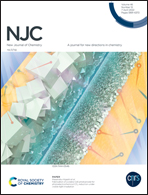Structures, solvatochromism, protonation and photoswitching of tetra-(ortho)substituted azobenzenes bearing 3,5-dimethoxy groups†
Abstract
Two new tetra-(ortho)substituted azobenzene derivatives bearing 3,5-dimethoxy groups in one of the aromatic rings and either 2,6-dimethyl or 2,6-dichloro groups in another one have been prepared and fully characterized, including by X-ray crystal structure analysis. Both compounds have twisted conformations with intramolecular possibly attractive short O–N contacts. Multiparametric correlation analysis of the absorption maxima in the UV-Vis spectra of both compounds in 17 solvents demonstrates that predominant factors in the solvatochromic properties of neutral molecules are the solvent basicity and polarity inducing bathochromic shifts of the π–π* bands. On the contrary, the absorption maxima of the protonated forms show hypsochromic shifts on increase in the solvent polarity. Spectrophotometric titrations in water reveal high basicity of both compounds with pKa values of their conjugated acids in the range from 6 to 7. Besides protonation, an efficient complexation of the di-methylated derivative with metal ions (Cu2+, Zn2+) in water is observed. Studies of photo-induced trans–cis isomerization of the new compounds demonstrates unusual solvent dependence of the rate of cis-to-trans thermal isomerization decreasing with increase in the solvent polarity. This may indicate a specific isomerization mechanism for ortho-substituted azobenzenes. Both new compounds undergo trans-to-cis isomerization with green light irradiation.



 Please wait while we load your content...
Please wait while we load your content...